ISSN ONLINE(2319-8753)PRINT(2347-6710)
ISSN ONLINE(2319-8753)PRINT(2347-6710)
Umar mukthar N1 and Sathishkumar R*2
|
| Related article at Pubmed, Scholar Google |
Visit for more related articles at International Journal of Innovative Research in Science, Engineering and Technology
This paper deals with an energy management strategy for a microgrid using artificial intelligent techniques. The proposed Energy management strategy aims in the maximum utilization of renewable energy sources considering the load demand, future availability of renewable energy sources and state of charge of the battery. An Artificial neural network model is developed for the forecasting of load and generation through renewable energies at 24- h- ahead with a time interval of 30 minutes. The efficiency of the microgrid strongly depends on the Battery scheduling process, which cannot be obtained through conventional optimization formulation. In this paper, A Fuzzy logic decision making system is used for the battery scheduling process which schedules the battery with the rate of charge and discharge. It also limits the battery from over charging and deep discharge and thus helps in increasing the lifespan of the battery. The Proposed model is simulated using the tools in Matlab/Similink environment and the results are found to be better than the literature models.
Keywords |
| Energy Management Strategy (EMS), Fuzzy Logic Controller, Neural Network, Microgrid, Artificial Intelligence Techniques, Distributed Generation. |
INTRODUCTION |
| In the worldwide scenario, fossil fuels contribute the major part of power generation. The usage of fossil fuels leads to many social threats like global warming, CO2 emission etc., also we are in the last few decades of the fossil fuel consumption and these fossil fuels won’t be available in the near future. The World countries are in search of non conventional energy resources to manage this threat and developed so many government policies for the development of new renewable energy sources. It is advisable to use the available sources efficiently than searching for a new one. Prediction and efficient use of renewable sources enables us to manage this social threat. There are several researches going on for the prediction of renewable sources like wind and solar energy.The techniques like locally Recurrent Neural methods are used for the prediction of wind speed in wind Power generating stations, using information from remote measurement stations. It uses local recurrent neural networks as advanced forecast models. To improve the performance of prediction, the training task is done using on-line learning algorithms based on the recursive prediction error (RPE) approach evolved for the minimization of errors giving accurate prediction [2]-[4]. Then the researchers combined two AI methods, they made use of fuzzy logicwith ANN in a hybrid approach to develop an adaptive neural fuzzy system model (ANFIS). ANN models are employed for the machine learning approach with the normalization of the given inputs. Fuzzy models are employed only in cases where a system is difficult to model or problems characterized with vague elements [3].The Back propagation algorithm is employed in the ANN for the wind prediction. The Data like wind speed, temperature and wind direction is considered and they are divided into two equal halves and the first half is used for training purposes and the second half is used for testing purposes [7].In [9], the authorsused stochastic and machine learning techniques to predict daily averaged global solar radiations one day ahead of time. Additionally, the authors applied two preprocessing strategies in order to normalize solar radiation namely clearness index and clear sky index. They used the techniques like ANNs, AR, Markov chains, Bayesian inference and clear sky normalization and tested that with the help of 19 years of data.In [11], the authors compared the exogenous meteorological data with the multilayer perceptron. They compared different forecasting methods including a persistence forecast, ARIMA reference predictor, an ANN with preprocessing using only endogenous inputs and an ANN with preprocessing using both endogenous and exogenous inputs using the 9 years of data and forecasts the day ahead wind speed, temperature and humidity [11]. In [12], the author make use of the Weather Research and Forecasting (WRF) data to implement a physical post processing technique to forecast Direct Normal Irradiance (DNI) based on the WRF model outputs and satellite measurements of aerosol and ozone levels. In this work, hourly GHI and DNI forecasted with the WRF model were compared against ground measurements for several locations. The comparison was carried for forecasting horizons for several days.In [13], The Bayesian techniques are used in order to design an optimal neural network based model for electric load forecasting. The Bayesian approach to modeling of NN offers significant advantages over classical neural network (NN) learning methods. When compared with the other techniques, the Bayesian technique offers the automatic tuning of regularization coefficients, selecting the most important input variables, deriving the uncertainty interval on the model output and the possibility to perform a comparison of different models and, finally, to design the optimal model. In [14] the authors implemented a parameter-wise optimization training process to achieve an optimal configuration of focused time lagged recurrent neural network (FTLRNN) models by combining the laguarre, gamma, and multichannel tapped delay line memory. They analyzed the prediction performance of the proposed model with the data having seasonal variation for one year. Delta-bardelta algorithm is used to accelerate the training ofNNs and to improve the stability of the convergence. In [15], the authors proposed a two step algorithm. In the first step, the wavelet transformation technique and the ANN are used. In the second step ANFIS is used. In this approach, the low order components of load and weather data are given to wavelet transform. The result shows improved accuracy in prediction of load and data.In [16], the authors analyses the problem of optimally controlling how to discharge and recharge a non-ideal battery so as to maximize the work it can perform over a given time period and still maintain a desired final energy level. They considered a Kinetic Battery Model (KBM) and formulate a finite-horizon optimal control problem when recharging is always feasible under the constraint that discharging and recharging cannot occur at the same time. They concluded that the Problem can be done numerically for the non linear battery charging problems. |
| This paper uses a Neural Network based hybrid computing model for wind speed prediction and Solar Prediction. Short term Load forecasting is done with Bayesian neural network model for a working day and a holiday type. The Neural network enables the machine learning process. The Decision making is done with the help of Fuzzy Logic Expert System. The outputs of Neural Networks and the State of Charge (SOC) of Battery are given as inputs to the fuzzy logic rule base and the battery is scheduled based on the decisions of fuzzy system. In section II, The microgrid environment is briefly introduced. The Aim is to schedule the battery with the rate of charge and discharge. The essential module to implement efficiently such energy management is the forecasting of the renewable energy sources and the load demand inside the microgrid.In Section III, the application of ANN is analyzed for short term load forecasting and power generation forecasting using renewable energies. Half an hour ahead solar forecasting and wind power forecasting and load demand forecasting is to be analyzed using Artificial Neural Network. Section IV deals with the Energy Management Strategy (EMS), where the optimization process depends on the management of storage facility. The efficient battery scheduling is to be considered for the actual and availability of the Renewable Energy Sources and the actual load demand and the electricity price and the fuel price. Such problems cannot be formulated through the general optimization algorithms and the conventional optimization formulations. The proposed Energy Management Strategy(EMS) approach consists of the optimization based on the Multiple Integer Linear Programming(MILP) Technique. The battery scheduling is used as the part of decision making process. The Way to solve the problem is to design a expert system which can decide, referring the Actual data and forecasted data, whether the battery should be charged or discharged referring to the time at which convenient rates. For this strategy, Fuzzy logic system offers a better resolution as a mathematical approach designed to model the vagueness and imprecision of a human cognitive process. Such intelligent ability enable us to categorize and manipulate the data allows the proposed battery scheduling approach and take decisions under the uncertainty or partial information. In Section V, the experimental results are analyzed and discussed related to the day ahead forecasting of Solar Power Generation(SPG), Wind Power Generation (WPG) and Load Demand (LD) at a 30 minutes time interval. |
MODEL OF THE DEVELOPED MICROGRID |
| A microgrid normally operates in a gridconnected mode, as power can be shared to the main grid. During the grid disturbances like power quality events, IEEE 1547 events, or faults, the Distributed generation and corresponding loads can be automatically separated from the distribution system to isolate the load from the disturbances and maintains a high level service without harming the transmission grid’s integrity through the sectionalizing circuit breaker (SCB). In terms of power flow, a DG unit can be either a dispatchable or nondispatchable unit. The power output of a dispatchable unit is controlled over set points provided by the EMS as a part of the central controller (CC) as the Diesel Generator and the microturbine that are controlled over fuel-in-flow adjustments and governor speed control. Also, the RE sources are typically nondispatchable Distributed Generation units and the power generated from them depends on the actual weather conditions (wind speed, temperature, and irradiance). The developed microgrid consists of six buses (Fig. 1) and is composed of a 20-kW battery connected to bus 1, a wind electric generation system(WEGS) rated 10-kWconnected to bus 2, a 15-kW rated Diesel Generator connected to bus 3,In bus 4, a 20- kWp rated photovoltaic (PV) array connected, and in bus 6, a 15-kW rated single-shaft microturbine (SSMT) connected. In the microgrid simulation model, inverter plays a major role of interfacing dc microsources with the ac side. The inverter control type used to supply a given active and reactive power is PQ inverter control. These types of inverters are used to interface the Micro turbine, the diesel generator, the PV array, and the battery during grid-connected mode of operation. The inverter control type used to “feed” the load with predefined values of voltage and frequency is voltage source inverter(VSI). |
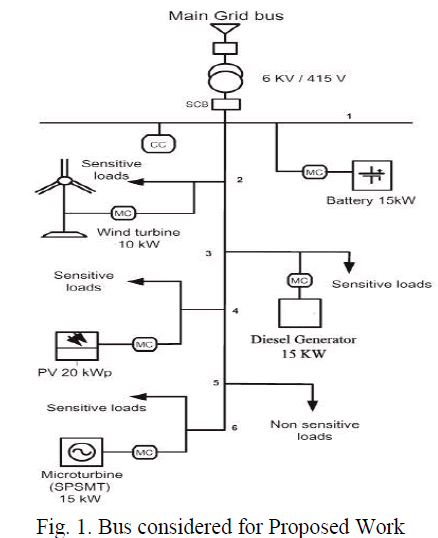 |
HYBRID WIND –PHOTOVOLTAIC – STORAGE SYSTEM |
| Hybrid Wind- Photovoltaic- Storage system consist of the independent sources which are tied to each other. The hybrid system can have a smooth output due to the mutual reinforcement of the renewable energy sources. Keeping the flat response in battery energy storage system, enables the power system to work in a better state with minimal fluctuation. |
| For training the neural network, one year data of solar power generation and wind power generation and load demand data are considered and the real time data collected from a Site at palladam, Tamilnadu, India. The permanent magnet synchronous generators and the solar panels are considered. The uncontrollability of the solar panel may decrease the stability of the system. It works on the basis of the Maximum Power point Tracking (MPPT) Approach. The battery energy station usually consists of batteries which have more charge-discharge times. However, less charge-discharge times can improve the service life of battery energy station effectively. Meanwhile, charge-discharge ability of battery is closely related to the state of charge (SOC) of battery. For example, Let us consider a lead-acid battery. When the SOC is higher than 0.6, the battery falls into deep charging. The charging current should be limited. Similarly, when the SOC is lower than 0.3, the battery falls into deep discharging. The discharging current should be limited. In other words, the battery has an optimal operation interval, i.e. (0.3, 0.6) for lead-acid battery. In the optimal operation interval, the battery has the best charge-discharge performance and longer service life. Considering that different kinds of batteries have different optimal operation interval and modeling simplifications. In this paper, The Lead acid battery is considered. |
| A. Proposed Artificial Neural Network |
| We chose a NN to model the electric load. Indeed, in the case of NN based models and as opposed, for instance, to polynomial regression techniques, no explicit knowledge of the functional form between the inputs and the output is needed. The most popular form of NN is the so called multilayer perceptron (MLP) structure. The MLP structure consists of a single input layer, several hidden layers and an output layer. The input layer gathers the model’s inputs vector x while the output layer yields the model’s output vector y, which is the corresponding forecast of the next day’s load at the same hour. Fig. 2represents a one hidden layer MLP. The hidden layer is characterized by several non-linear units (or neurons). The non-linear function (also called activation function) is usually the tangent hyperbolic function |
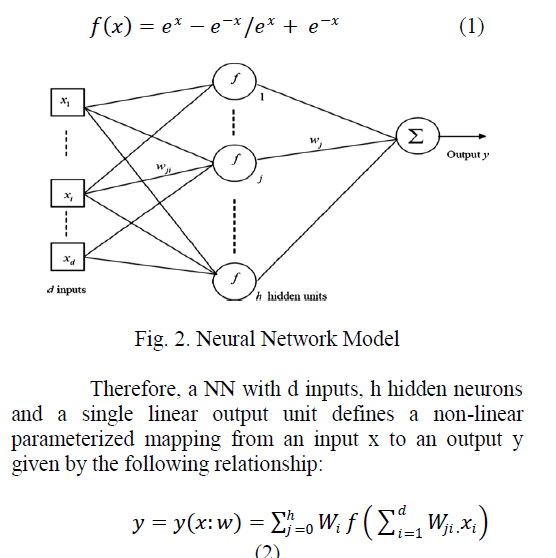 |
| The parameters of the NN model are given by the so called weights and biases that connect the layers between them. The NN parameters, denoted by the parameter vector w, govern the non-linear mapping. |
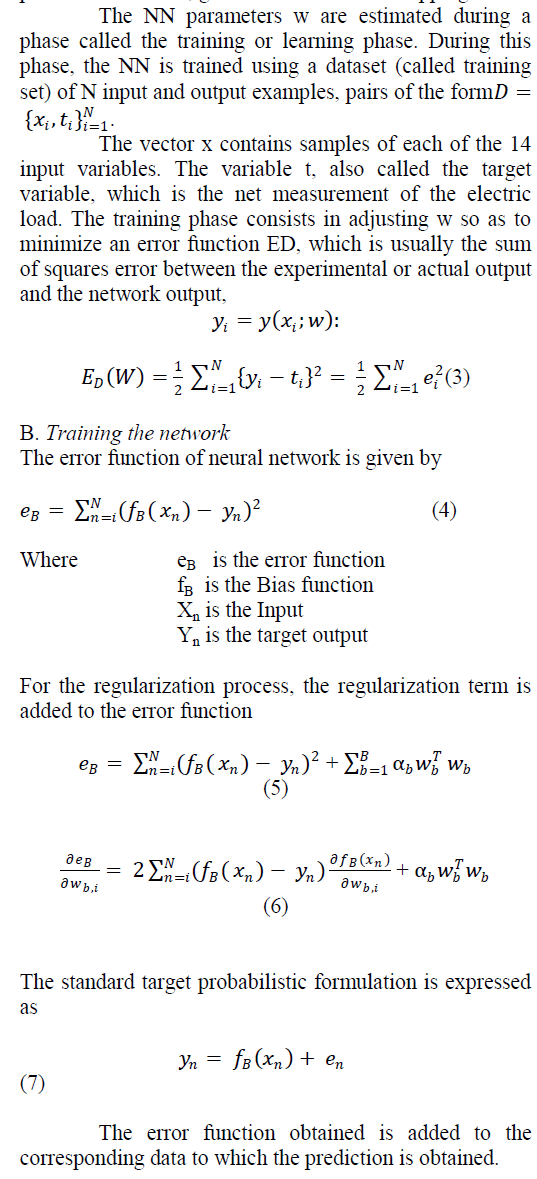 |
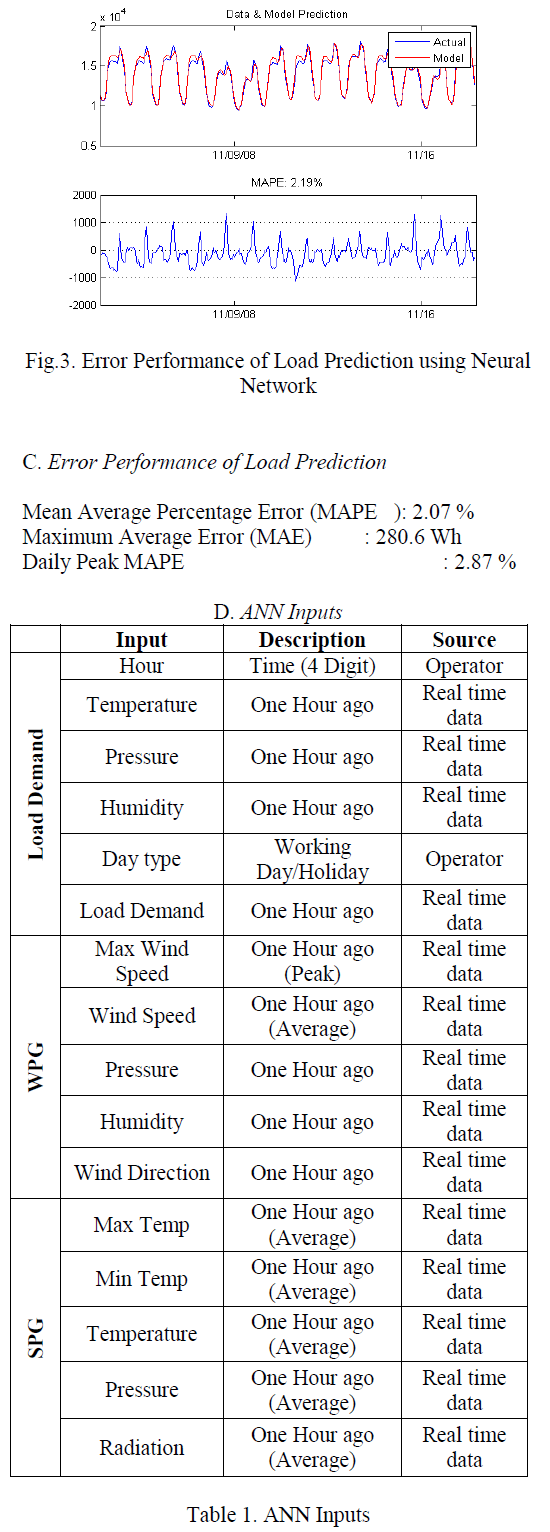 |
ENERGY MANAGEMENT STRATEGY |
| The Energy Management Strategy deals with the battery scheduling process. In this regard, the Battery State of Charge and the forecasted load data are considered. An expert system is modeled for the decision making. For this process, Fuzzy logic expert system is considered. |
| A. Battery Scheduling |
| A 15-kWh lead–acid battery is used as storage system. These batteries are cheap but suffer from deep depth of discharge (DOD) as it decreases its lifetime by reducing the expected average cycles (Fig. 5). In this paper, the lead-acid battery efficiency is assumed to be 90% for both charging and discharging efficiencies. |
| 1) Charging |
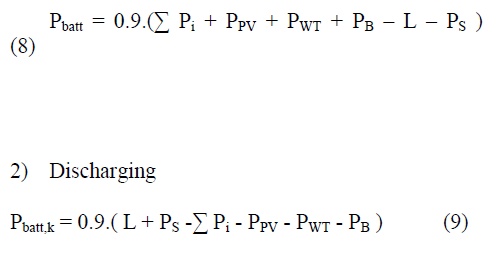 |
| B. Fuzzy Logic Expert System |
| The battery scheduling is a part of online energy management system, which is done using the fuzzy logic controller. The way to solve this problem is to decide, referring to the forecasted data, whether the battery should becharged or discharged and at which rates. This process takes account of the safe operation of the battery, minimization of the operating cost and fuel cost. |
| In this paper, fuzzy logic based expert system is applied for the battery scheduling. Because the fuzzy sets handle the vagueness and partial output like that of the human cognitive process. also the Fuzzy logic controllers can be plug and play in the desired environments. |
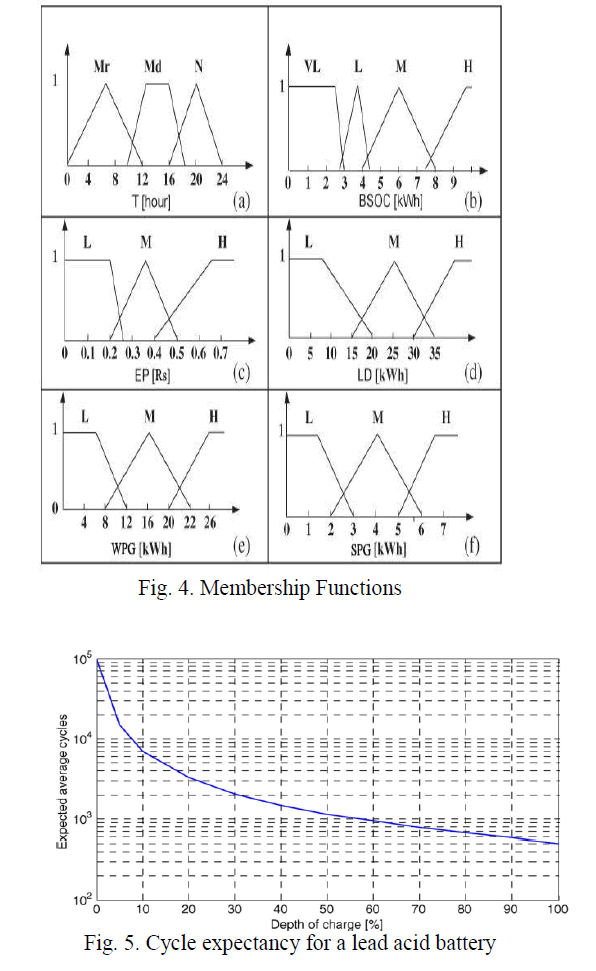 |
| 1. Fuzzification Process: |
| The fuzzy based expert system applied to the battery scheduling based on the measured real time data or forecasted data as follows: Time(T), The Battery State of Charge(BSOC), Electricity Price(EP), Load Demand(LD), Solar Power Generation(SPG) and Wind Power Generation(WPG). The input membership functions forward a degree of membership related to its respective input patterns to the inference engine. The time membership function that takes the actual time and assigns a degree to the membership function for the fuzzy set in the graph is shown in Fig 4(a). Mrstands for Morning, Md stands for Midday and N stands for Night. The BSOC membership functions, the battery assigned into four membership sets listed as VL (very low), L (low), M (medium), and H (high) are shown in Fig 4(b). The Electricity Price membership function is shown in Fig 4(c), where the input is the actual EP (in Rupees per KWh) assigned into three membership sets listed as L (low), M (medium), and H (high). The LD membership functions, assigned into membership sets listed as L (low), M (medium), and H (high) are shown in Fig. 4(d). The membership functions of Solar Power Generation(SPG) and Wind Power Generation (WPG) are shown in Fig 4(e) and Fig. 4(f)respectively. |
| 2. Inference Engine: |
| When the degrees of membership function of each fuzzy set determined for a input and forwarded to the inference engine which evaluates the rules. A typical fuzzy rule is represented in the form, If (WPG is ”H”) and (SPG is “L”) and (T is “Mr”) and (BSOC is “H”) and (LD is “H”) and (EP is “M”) and (Reg is “L”) Then (Discharge “M”). The fuzzy rules summarize the efficient battery scheduling based on human expertise and the goal is to decide the most accurate action whether to charge or discharge and at which limit. Once the criteria for the rules met, the output degrees of membership would be asserted according to the membership values of the inputs. |
| 3. Defuzzification: |
| When the Output membership function is calculated by the inference engine, the next step is defuzzification into a output signal as charging rate or discharge rate. |
SIMULATION RESULTS |
| The Day ahead forecasting of Renewable power generation and load is done using the multilayer perceptron neural network and the Bayesian approach is employed for the prediction of the Load Demand (LD). The Bayesian approach gives the weightage to the important parameters and the outputs are listed in table. Similar to the data shown, the LD and renewable power generation is forecasted for the whole day in the interval of 30 minutes. |
| The Data given to the Fuzzy logic expert system are processed in the inference engine. Depending on the rules, the outputs are defuzzified and outputs are found namely Charging rate and Discharge rate. |
| The charging and discharge rate for the given data are given to the charge controller, which limits the rate of charge of the battery and the inverter which controls the rate of discharge of the battery. |
| The charging rate for the Controller is as shown in the fig.6. Based on the rate of charge, the charge controller limits the battery from overcharging and limits the Depth of Discharge (DOD) by considering the Battery State of Charge (BSOC) |
| The Discharge rate to be given to the inverter is found using the Fuzzy logic expert system. Based on the Data given, the discharge rate for the particular time is found and as shown in the fig.7. The Energy Management System (EMS) limits the discharging considering Battery State of Charge (BSOC) and Load Demand (LD). |
 |
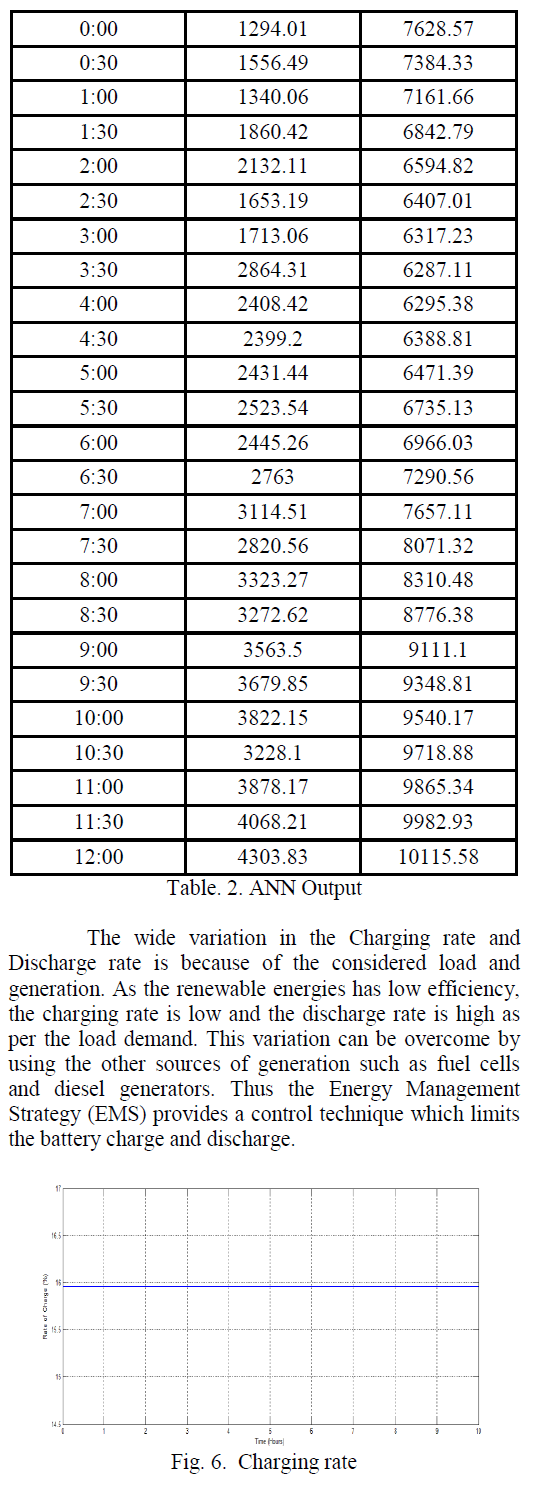 |
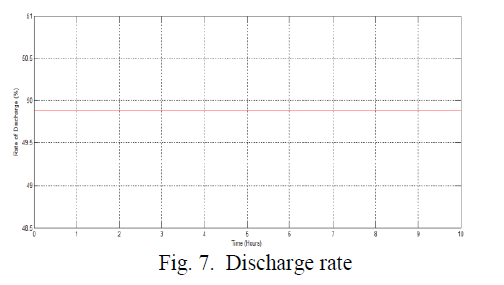 |
References |
|